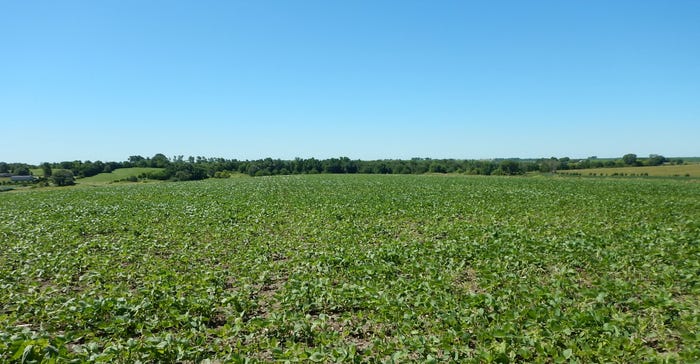June 26, 2017

We are now past the summer solstice, so daylight hours will be getting shorter, and we are starting to see more flowers on soybean plants in fields. It’s time to remind farmers and applicators that we are heading toward the end of the dicamba herbicide application window on Xtend soybeans. I’ve received lots of questions about when we have to stop using dicamba on Xtend beans — the new soybeans that have both dicamba and glyphosate herbicide tolerance. Let’s walk through some of the terms on the dicamba label and how to interpret them.
There isn’t really a true “cutoff date” for applying dicamba postemergence on soybeans. The label tells us to stop applications based on growth stages of soybean plants. The application cutoff is not date-specific. To apply this herbicide properly, you need to scout fields for plant development and keep an eye on weed size. You want to spray when weeds are 4 inches or less.
Interpreting herbicide label directions
Reading the labels, you see that in-crop applications of the approved dicamba herbicide products can be made up to and including beginning bloom (R1 growth stage of soybeans). The labels specifically say “do not make in-crop applications after beginning bloom (R1 growth stage).”
That is a little complicated, and growers tell me they are hearing different ideas about when to stop spraying. With experience as a retail agronomist, and as a commercial and private applicator, I’m used to having to decipher convoluted label statements, so I’ll give this a shot.
Since the labels say we can make applications through R1, if we can meet all the other parameters laid out in the label directions, we may not have to stop spraying dicamba at the very first flower we see, as some farmers and applicators are hearing. But we also have to know when to stop cold, which is when we hit R2. That means we need to know exactly what defines R1 growth stage and when it ends, and we have to scout our fields prior to loading up to spray.
When does R1 growth stage end? The R1 stage, or beginning bloom, means a plant has one flower open at any node on the main stem. Typically, soybeans are around V6 to V10 at that time, but this depends on many factors. In my experience, flowering almost always starts on the third to sixth node on the main stem of a soybean plant.
As a point of further clarification, a growth stage begins when half or more of the plants in a field are at or beyond that stage. So when does R1 end and R2 start? It’s when there’s an open flower at one of the two top nodes of the main stem and at least one of these two upper nodes is showing a fully developed leaf.
How many days does the R1 timeframe last? As usual with any agronomy answer, “It depends.” Scouting will be the way to know. However, in my experience, usually three to five days is what I see as R1; it goes pretty fast. The scientific literature says it can last from zero to seven days; so if R1 did indeed last zero days, we would be done spraying dicamba. I don’t recall seeing an entire field of soybeans skip the R1 growth stage altogether (I’ve only seen just a few plants skip R1), but it is possible.
The bottom line is that the timeframe “including beginning bloom,” which the dicamba label lists as the end of the application window, is short and unpredictable.
When does soybean flowering usually start? Again, that depends, and it is triggered by not only longer nights, but also planting date, varietal differences, environmental conditions and a slew of other factors. The summer solstice, which was June 20, is often when we start noticing flowers on soybean plants in fields, but in many years we have soybeans starting R1 a week or more ahead of the solstice. Scouting is the only way to know for sure.
On June 24 I looked at a lot of soybean fields in south-central Iowa and found about a third of them had flowers, but not all of these fields were at 50% flowered yet. A few were truly R1, and the ones with some flowers but not quite to 50% were close and would probably hit R1 in the next day or two. The other two-thirds of the fields were close but didn’t have any flowers that I could find, and I didn’t find any beans at R2, but that doesn’t mean they aren’t out there somewhere.
Need to be completing applications soon
It’s important that you understand the label and application requirements for the new dicamba herbicide products to be successful.
In conclusion, we need to be wrapping these dicamba herbicide applications up pretty darn soon! I don’t want to be the guy they make an example of for spraying past the end of R1. Be sure you understand your soybean growth stages, scout well prior to spraying, and err on the side of caution if there is any doubt as to whether the beans are past R1 growth stage when you are considering making a postemergence application of dicamba.
McGrath is the On-Farm Research and Extension coordinator for the Iowa Soybean Research Center at ISU. Contact him at [email protected].
About the Author(s)
You May Also Like






